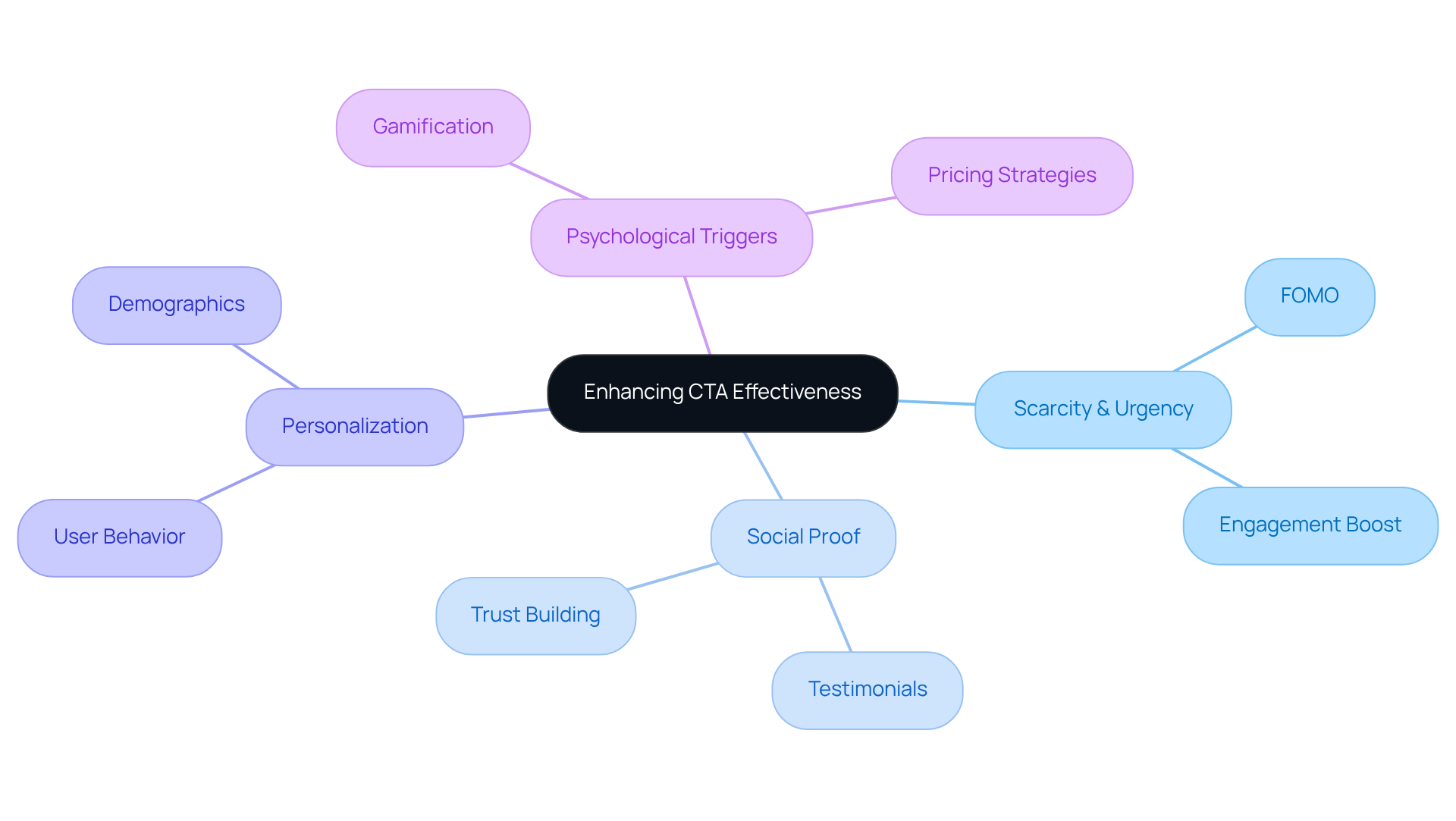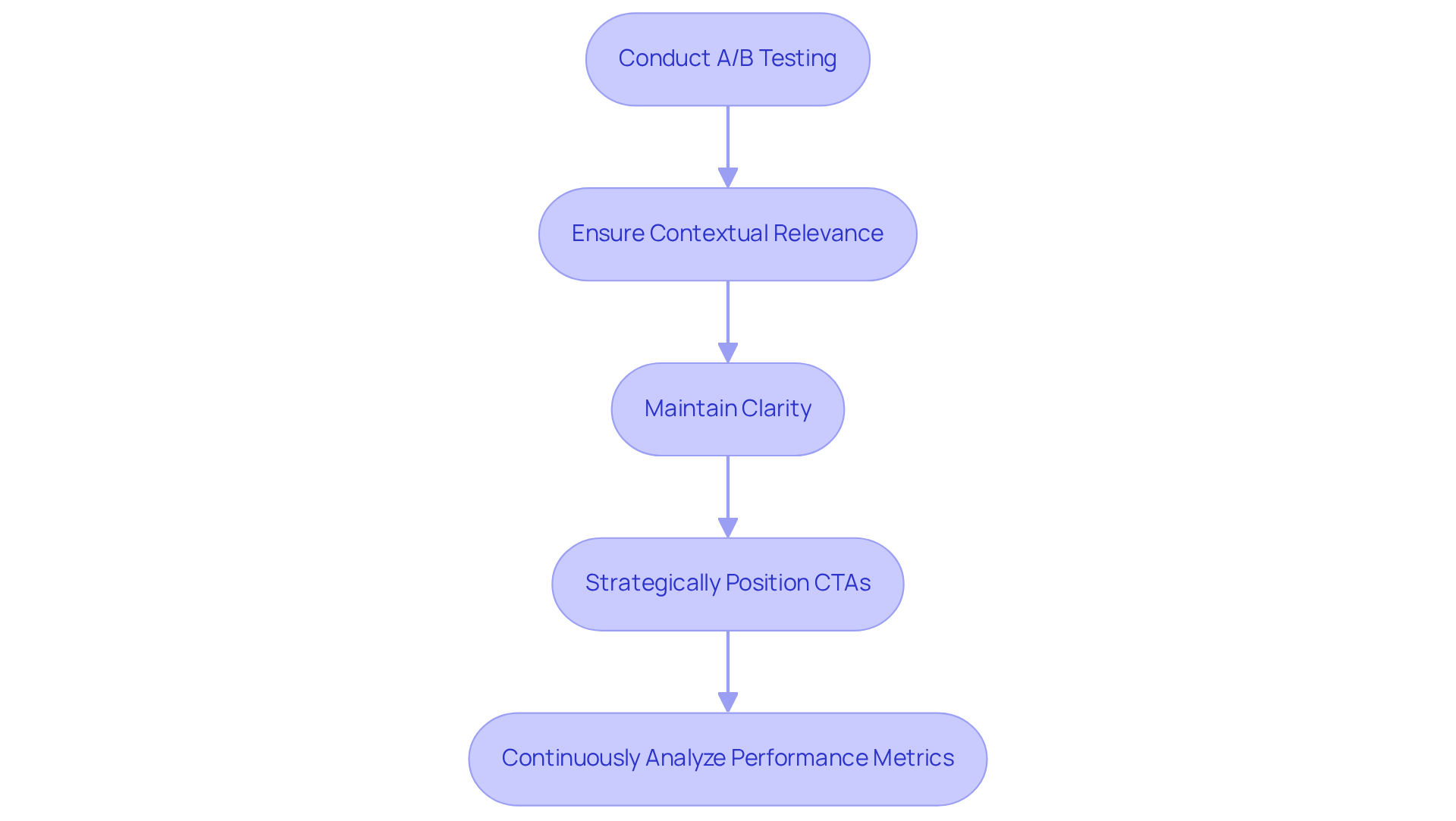
Overview
Effective Calls-to-Action (CTAs) are crucial for the success of direct-to-consumer (DTC) brands. These elements not only enhance consumer engagement but also significantly boost conversion rates. By implementing strategic CTAs, brands can drive customer actions that lead to increased profitability.
Successful CTAs share key characteristics:
- Clarity
- Urgency
A clear message ensures that consumers understand what action they need to take, while a sense of urgency compels them to act promptly. Research shows that well-crafted CTAs can lead to substantial increases in customer interactions, ultimately benefiting the brand's bottom line.
To illustrate this point, consider the impact of a well-designed CTA in a recent campaign. Brands that utilized compelling CTAs reported a marked increase in conversion rates, demonstrating the effectiveness of these strategies. This evidence underscores the importance of investing time and resources into developing CTAs that resonate with consumers.
In conclusion, DTC brands must prioritize the creation of effective CTAs. By focusing on clarity and urgency, and by leveraging data-driven insights, brands can enhance their consumer engagement and drive profitability. The right CTAs not only prompt immediate action but also foster long-term customer relationships.
Introduction
Understanding the nuances of consumer behavior is essential for direct-to-consumer (DTC) brands aiming for success in a competitive marketplace. At the core of effective marketing is the Call-to-Action (CTA)—a straightforward yet powerful tool that can dramatically influence customer engagement and conversion rates. The pressing question is: how can brands create CTAs that not only grab attention but also drive action?
This article explores proven strategies and psychological insights designed to enhance CTA effectiveness. By leveraging these insights, DTC brands can significantly improve their marketing outcomes and cultivate enduring customer relationships. With the right approach, your CTAs can transform from mere prompts into compelling invitations that resonate with your audience.
Define the Call-to-Action (CTA) and Its Importance for DTC Brands
A Call-to-Action (CTA) is regarded as the best cta in marketing, functioning as a prompt on websites or in promotional materials that encourages users to take specific actions, such as 'Buy Now', 'Sign Up', or 'Learn More'. For direct-to-consumer (DTC) brands, the best cta are crucial as they directly influence purchase levels and enhance customer interaction.
Functioning as the bridge between consumer interest and action, well-designed calls to action, or the best cta, guide potential customers through the sales funnel. This ultimately drives profitability by converting visitors into paying customers. Studies reveal that the best cta, when clear and persuasive, can lead to substantial increases in success rates. For instance, one strategically positioned call to action can boost outcomes by as much as 266%. Furthermore, incorporating the best cta with action-oriented language can elevate conversion rates by 121% compared to passive alternatives.
In a competitive landscape where DTC brands vie for consumer attention, leveraging the best cta is essential for optimizing marketing strategies and achieving sustainable growth. By integrating these insights into your marketing approach, you can significantly enhance your brand's performance and customer engagement.

Identify Key Characteristics of Effective CTAs
Effective calls to action (best cta) are essential for driving user engagement, embodying several critical characteristics: clarity, conciseness, and action-orientation. A successful CTA employs strong action verbs that motivate users to engage, such as "Get Started," "Shop Now," or "Join Free."
Creating a sense of urgency is vital; phrases like "Limited Time Offer" or "Only a Few Left" encourage immediate action. Visibility is also essential; calls to action must stand out visually on the page, utilizing contrasting colors and strategic placement to capture attention. For optimal visibility, position CTAs at the top of a newsletter or email.
Moreover, effective CTAs often incorporate a clear value proposition, communicating the benefits of clicking. For instance, a CTA stating "Get Your Free Trial" not only encourages action but also highlights the benefit to the individual. Statistics show that action-oriented best ctas can greatly enhance success percentages, with well-crafted best ctas increasing average success levels from 2.4% to as much as 11.5%.
By applying these optimal methods, DTC brands can significantly improve audience interaction and achieve the best CTA for greater success in sales.

Leverage Consumer Psychology to Enhance CTA Effectiveness
Harnessing consumer psychology is essential for maximizing the effectiveness of the best CTA strategies. Key psychological principles, particularly scarcity and urgency, motivate individuals to take prompt action. Phrases like 'Only 3 Left in Stock!' evoke the fear of missing out (FOMO), compelling consumers to act swiftly. Statistics reveal that urgency-driven best CTAs significantly enhance effectiveness; incorporating urgency in the best CTA has been shown to boost viewer engagement and encourage immediate actions.
Incorporating social proof amplifies this effect. Displaying testimonials or client reviews next to the best CTA builds trust and encourages clicks, as consumers are more likely to engage with brands that show credibility through peer validation. A case study from Parah Group illustrates that by redesigning a homepage to highlight social proof and reviews, one apparel brand achieved a 35% increase in success, showcasing the influence of social validation on consumer behavior.
Personalization is recognized as the best CTA among powerful strategies. Customizing the best CTA according to user behavior or demographics makes them more relevant and appealing. For example, a returning customer might see a CTA stating, 'Welcome Back! Enjoy 20% Off Your Next Purchase,' acknowledging their loyalty while incentivizing further action. Studies indicate that the best CTA can boost success metrics by as much as 202%, underscoring the significance of this approach. In another case study, a cannabis brand improved their average order value (AOV) by 90% through targeted offers and personalized landing pages, demonstrating the effectiveness of tailored messaging.
By strategically employing these psychological triggers—such as gamifying the progress bar for free shipping thresholds and optimizing product pricing—DTC brands can create engaging calls to action that resonate with consumers. This ultimately drives higher success levels and fosters long-term customer relationships. Parah Group's innovative CRO strategies have proven transformative for DTC brand profitability, as evidenced by the significant results achieved across various case studies.

Implement Proven Strategies for Crafting Compelling CTAs
To create the best cta, DTC brands must adopt several effective strategies that not only capture attention but also drive conversions.
-
First, conducting A/B testing on various elements—such as wording, colors, and placements—is crucial. Research shows that A/B testing can lead to conversion rates that are up to 28% higher on average. This data underscores the importance of experimentation in optimizing the best cta.
-
Second, it’s essential to ensure that calls to action are contextually relevant. Aligning them with surrounding content maintains a logical flow and helps create the best cta for enhancing audience engagement. When the best cta resonates with the content, it naturally draws the reader's attention.
-
Third, clarity is key. Use direct language that eliminates ambiguity; for instance, replace vague prompts like 'Click Here' with specific actions such as 'Download Your Free Guide Now' to achieve the best cta. This straightforward approach not only informs but also motivates the audience to act.
-
Fourth, strategically position calls to action where users instinctively glance. Placing them above the fold or at the end of captivating content can significantly boost engagement. Research indicates that the best cta positioned 'above the fold' can experience up to 84% higher engagement, highlighting the importance of placement in driving user interaction.
-
Lastly, continuously analyze performance metrics to refine and optimize CTAs over time. Adapting to evolving consumer preferences ensures sustained effectiveness. By regularly reviewing data, brands can make informed adjustments that help them create the best cta, keeping their calls to action relevant and impactful.

Conclusion
The effectiveness of Calls-to-Action (CTAs) is paramount, especially for direct-to-consumer (DTC) brands aiming to thrive in a competitive landscape. CTAs serve as essential prompts that guide consumers toward making purchases or engaging with content. When crafted thoughtfully, these CTAs are pivotal in transforming interest into action. Their strategic design and placement can significantly boost customer interaction and drive profitability, making them indispensable tools in any DTC marketing strategy.
Key characteristics of effective CTAs include clarity, urgency, and personalization. Strong action verbs create a compelling call, while a sense of urgency encourages immediate responses. Ensuring that CTAs are visually prominent and contextually relevant enhances their effectiveness. Moreover, leveraging consumer psychology—such as incorporating social proof and tailoring messages to individual behaviors—can lead to substantial increases in engagement and conversion rates. Proven strategies like A/B testing and continuous performance analysis empower brands to optimize their CTAs for maximum impact.
Ultimately, the success of DTC brands hinges on their ability to engage consumers effectively through compelling CTAs. By adopting the insights and strategies outlined, brands can enhance their marketing efforts and foster long-term customer relationships. Embracing the art and science of CTAs is not merely an option; it is a necessity for driving growth and achieving sustainable success in today’s dynamic marketplace.
Frequently Asked Questions
What is a Call-to-Action (CTA)?
A Call-to-Action (CTA) is a prompt on websites or in promotional materials that encourages users to take specific actions, such as 'Buy Now', 'Sign Up', or 'Learn More'.
Why are CTAs important for direct-to-consumer (DTC) brands?
CTAs are crucial for DTC brands as they directly influence purchase levels and enhance customer interaction, serving as the bridge between consumer interest and action.
How do well-designed CTAs impact sales?
Well-designed CTAs guide potential customers through the sales funnel and can drive profitability by converting visitors into paying customers.
What impact can a strategically positioned CTA have on success rates?
A strategically positioned CTA can boost outcomes by as much as 266%.
How does action-oriented language in CTAs affect conversion rates?
Incorporating action-oriented language in CTAs can elevate conversion rates by 121% compared to passive alternatives.
What is the significance of leveraging CTAs in a competitive market?
Leveraging CTAs is essential for optimizing marketing strategies and achieving sustainable growth, especially in a competitive landscape where DTC brands vie for consumer attention.
FAQs











